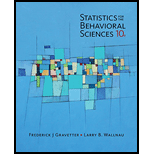
Concept explainers
The following data are from a repeated-measures study comparing three treatment conditions.
a. Use a repeated-measures ANOVA with
b. Double the number of scores in each treatment by simply repeated the original scores in each treatment a second time. For example, the
the SS value for each treatment. For the new data, use a repeated-measures ANOVA with
c. Describe how doubling the
| Treatments | |||||
| Person | I | II | III | Person |
Totals
- If there is significant different between the three treatments
- The size of treatment effect
- Effect of doubling sample size
Answer to Problem 17P
Solution:
There is significant difference between the three treatments, the effect size is 0.8485, and doubling the sample size alters the F ratio but the effect size remains same.
Explanation of Solution
Information given:
Let t denote number of treatments
S denote numbers of subjects
N denote total number of subjects in all treatments
We got t = 3
S = 4
N = 12
| Treatments | |||||
| Person | I | II | III | Person Totals | |
| A | 1 | 4 | 7 | Pa=12 | |
| B | 4 | 8 | 6 | Pb=18 | N=12 |
| C | 2 | 7 | 9 | Pc=18 | G = 60 |
| D | 1 | 5 | 6 | Pd=12 | |
| M =2 | M=6 | M=7 | |||
| SS=6 | SS=10 | SS=6 | |||
Formula used:
Formula of effect size:
Calculations:
Answer to part a:
Fcritical value for df between 2 and df error 6 for alpha = 0.05 is: 5.14
Inference: Since F statistic 16.77 is greater than F critical 5.14, this implies that there is significant difference in the treatments
Effect size:
Answer to part b:
K = 3 since the treatments are three
F critical, for df between = 2, and df within = 14 for alpha = 0.05 is 3.74
Inference: Since F statistic 179.0210 is greater than F critical 3.74, this implies that there is significant difference in the treatments
Answer to part c:
The if the sample size is doubled the F ratio's value increases further, but the effect size does not alter
Conclusion:
Thus we conclude that the treatments have a significant effect, and the effect size remains same even if the sample size is doubled.
Justification:
This process of repeated measures of ANOVA is applied because there are 3 groups and we need to compare the mean of the same characteristic in the three groups. ANOVA is used to compare means of multiple groups together. It lets us know if there is significant difference between the means of 3 different treatments.
Want to see more full solutions like this?
Chapter 13 Solutions
Statistics for The Behavioral Sciences (MindTap Course List)
 Calculus For The Life SciencesCalculusISBN:9780321964038Author:GREENWELL, Raymond N., RITCHEY, Nathan P., Lial, Margaret L.Publisher:Pearson Addison Wesley,
Calculus For The Life SciencesCalculusISBN:9780321964038Author:GREENWELL, Raymond N., RITCHEY, Nathan P., Lial, Margaret L.Publisher:Pearson Addison Wesley, Glencoe Algebra 1, Student Edition, 9780079039897...AlgebraISBN:9780079039897Author:CarterPublisher:McGraw Hill
Glencoe Algebra 1, Student Edition, 9780079039897...AlgebraISBN:9780079039897Author:CarterPublisher:McGraw Hill

